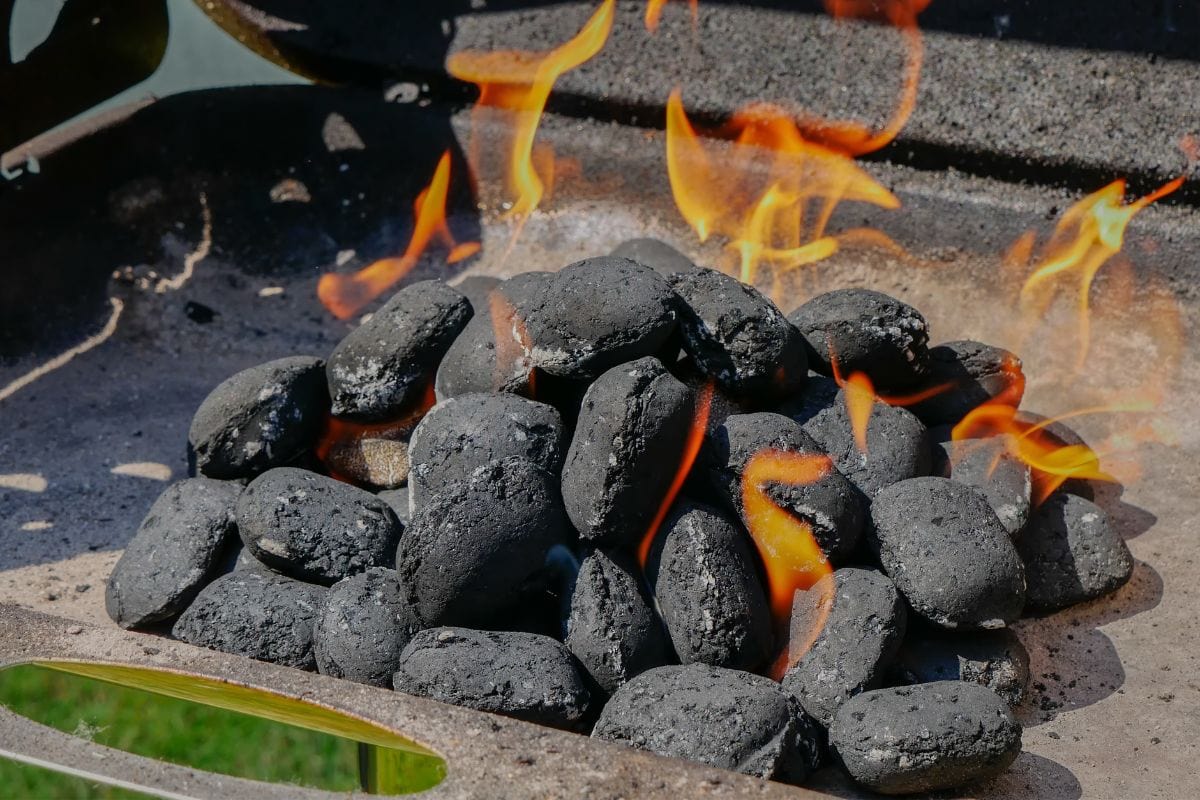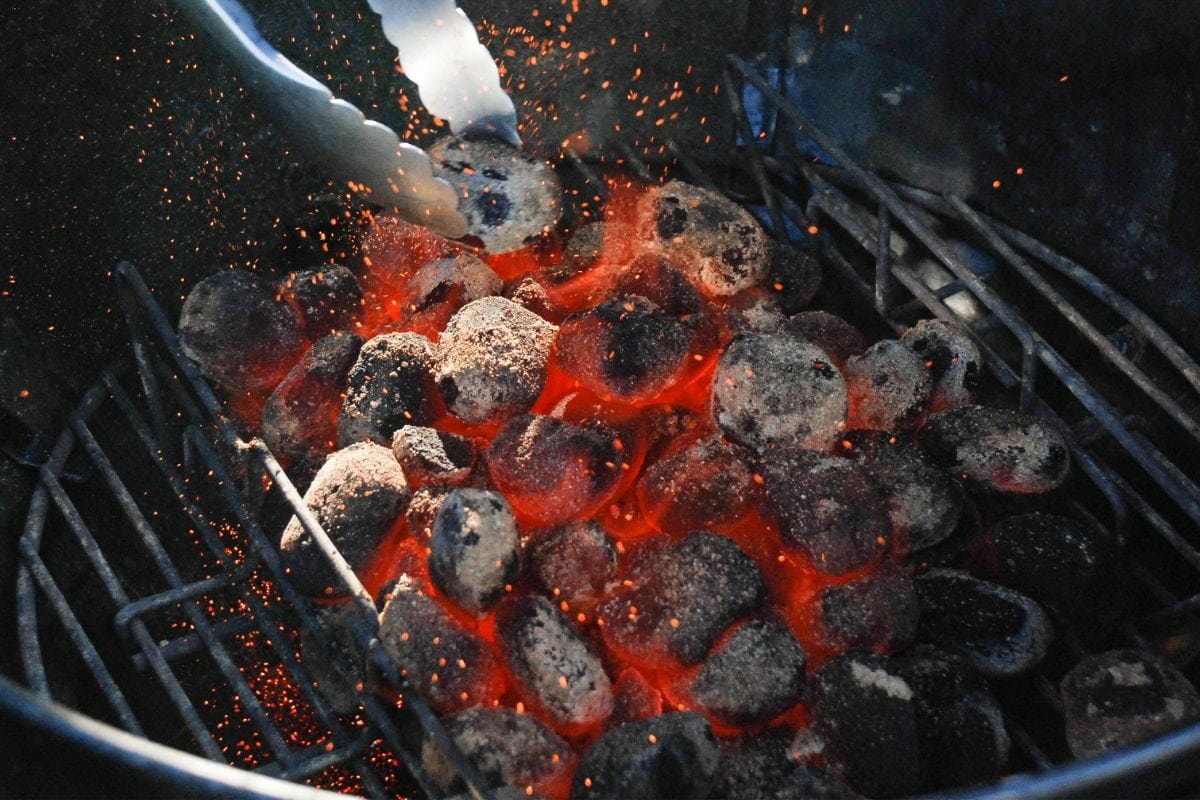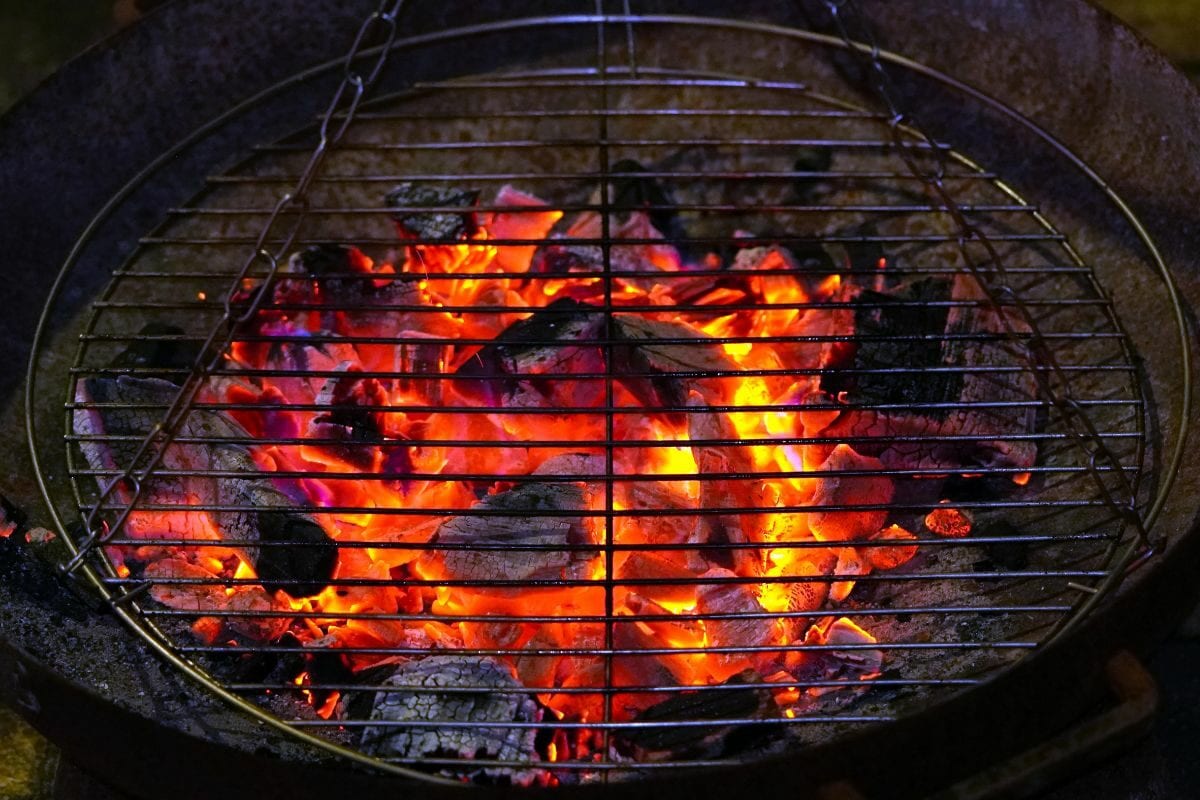I’ve got some great news for all you thrifty charcoal grillers out there – those dusty gray charcoal briquettes at the bottom of your grill can be reused! Keep reading, and I’ll fill you in on the best way to do it.
In addition to being an outdoor cooking fanatic, I’m a cheapskate. So when I learned a decade ago that I could save money reusing charcoal briquettes, I never looked back. To me, grilling means charcoal grilling – the live fire imparts a flavor you can’t buy in a jar. So I’m constantly reusing partially burned charcoal and saving big bucks! Well, medium bucks anyway.
Throwing away used briquettes is like tossing away money. Save some green. I’ll walk you through all the steps for reusing old charcoal. Stop dumping your used charcoal. Join the cheapskate revolution. Hope you’re fired up!

You can reuse charcoal, and I’m here to walk you through the whole process. All the tips in this guide apply to both lump charcoal and standard briquettes (such as the most popular brand, Kingsford Briquettes). I’ll break down the differences between briquettes and lumps in a bit. Let’s go.
Let’s start at the end – the end of your last cook. You can’t reuse charcoal if you don’t have any used charcoal.
You need to close all the vents after you’ve finished grilling. Most grills have two, though some grills have more – PKs have 4. This will starve your grill of oxygen, so instead of flaming into ash, your leftover charcoal will slowly extinguish, leaving you with a pile of used charcoal.
Once your grill cools down, put your grill cover on. It needs to be completely cooled, or the cover will melt. If you’ve got a Big Green Egg or Kamado-style smoker, let it cool at least overnight. They are basically airtight and take a long time to cool down.
The cover will keep the rain out of your grill- rain can sneak through your dome vent and cause the old coals to absorb moisture. It’s really hard, if not impossible, to get good hot coals going if your charcoal is wet.
Keeping your grill covered also keeps moisture off your grill, protecting your investment. Keep it dry by keeping it covered!
Don’t use lighter fluid to light your charcoal briquettes, and don’t buy any charcoal that’s labeled “easy light charcoal,” which is infused with fluid. Growing up, I thought lighter fluid was a seasoning, right up there with salt and pepper. I can promise you. It’s not.
The problem is that the fluid tastes bad, and the aroma is off-putting. Those off-flavors work their way into whatever you are grilling and smoking. Fluid also contributes to greenhouse gas emissions.
Ditch the fluid. Use a chimney starter instead. (More on how to use a chimney starter in a bit.)
Next, we’re going to use a grill shovel or other tool to get all that charcoal ash and crushed charcoal off your old charcoal. This step is crucial, so don’t sleep on it.
Some people use tongs or their spatula to do this – I’d avoid doing so. If you do, make sure you fully wash your grilling tools before they touch whatever you are cooking. You don’t want old charcoal ashes on your food, people.
Why are we removing the crushed charcoal? Well, old charcoal won’t burn hot with too much ash and too many little pebbles of used briquettes in your cooking chamber. The small nuggets of old charcoal reduce airflow. The goal is to remove all the smaller pieces until we’re left with larger, solid pieces. Sound good?

To do this, I use a grill shovel, but I know some grill bosses that use a deep frying basket. Either method will get the job done. Your goal is to move the old charcoal around, forcing any of the smaller charcoal pieces to fall into your ash collector.
If you’re using a basket, sift the small pieces of old coals. Catch them in a metal container, metal bucket, or other non-combustible container. Let’s keep those fires contained to our grills!
Again, don’t skip this step. If you do, your old briquettes will smother the fire in the firebox, and you’ll struggle to get a hot grill going.
Usually, I fill a chimney starter halfway with new briquettes. I determine how much fresh charcoal based on 2 things: what food I’m making and how long it takes to cook.
If I’m firing up the grill for an everyday type of meal, like chicken pieces, hamburgers, and the like, a half-full charcoal chimney starter will provide enough charcoal for grilling. The new charcoal mixed with the old, unburned charcoal will provide plenty of coals.
If I’m slow smoking something that will take a long time, like brisket or ribs, I will fill the chimney starter all the way to the top with new lump charcoal or briquettes. This will ensure enough new fuel for a longer smoke.
I also fill that chimney starter to the brim if I’m making something that requires blazing-hot cooking temperatures. Skinny steaks and grilled pizza are prime examples of foods that need to be cooked over intense heat.
Think about what you’ll be grilling or low and slow cooking, and put as much charcoal in your starter as you’ll need.
To light your starter – stick some paper towel or old newspaper (hard to come by these days) in the bottom, and fill to your desired level with fresh charcoal. Now, light the paper with a lighter. Let it burn for 10-15 minutes until a flame is coming from the top coals and the bottom coals have started to turn ashy.
Light your starter on your grill grates or a metal table. A warning – don’t light it over wood or plastic. Plastic will melt, and lighting it on wood is a fire hazard. Be safe.
Dump the lit charcoal on top of the previously used charcoal briquettes. Set up your grill for indirect or direct grilling, let the grill come to the appropriate temperature, and you’re ready to prepare some incredible barbeque.
We’re back to the beginning. Once you’re done with your grilling or smoking session, close those vents so the hot charcoal can die out and be ready for your next cook. The coals will starve of oxygen because there’s no airflow, and the fire die. Now you’ve got a fresh batch of old briquettes.
Let me hit you with one of my pro tips: every 10th cook or so, I leave my vents fully open and allow maximum airflow. I let the coals burn out completely until they disintegrate into ashes.
The reason I let my coal burn out is that it’s an easy way to clean my grill and my grill grates. Think of it like the self-cleaning function on your oven. It’s the same principle; cleaning the interior by blasting it with heat.

Look for good quality natural charcoal for your next cook. I like Kingsford – the brand was launched by Henry Ford, who saw charcoal as the perfect use for leftover wood and sawdust from automobile production. They’ve been the industry standard for almost a century.
But the right charcoal is whatever works best for you! Lump charcoal is a popular alternative to the briquette. It’s made from pure hardwood and burns hotter, so if you’re cooking hot and fast as opposed to low and slow smoking, charcoal lumps make plenty of sense.
Lump charcoal is irregularly sized compared to its cousin, the charcoal briquette. There can be a learning curve when using it for the first time. Try to get a good mix of small, medium, and large lumps of charcoal in your starter. If you use too many of the smaller lumps, the charcoal will get compacted, and you won’t get a good fire going.
Charcoal that’s got additives or chemicals is a no-no for me. If you choose to use this type of charcoal, toss the cooled ashes in the garbage – don’t try to recycle them on your plants (more on that in a bit).
This is a problem many backyard BBQ enthusiasts run into – they reuse charcoal, only to find that it produces a fire that takes forever to come to temperature and doesn’t reach that high temperature suitable for most types of charcoal grilling. I’ve got you!
Let me help you out. The problem isn’t with the reused charcoal. The problem is operator error. Make sure you get all the smaller bits of old charcoal to fall into your ash trap. Then add fresh charcoal that’s screaming hot from your chimney starter.
Don’t try lighting old charcoal in your chimney, as that’s a recipe for a poor burn. Use new charcoal. Check that every grill vent is open for maximum airflow, and you’re off to the races.
The dome thermometer on my Kamado cooker goes to 700°F, and I can make that thermometer redline (go past 700°F) using these methods.
You can either toss it in the trash once it’s completely cooled, or you can use spent charcoal on your compost pile. The charcoal needs to be additive free if you’re using it as fertilizer. It’s full of potash (potassium carbonate), which is a nutrient that many plants thrive on. Wait until the ashes have cooled off before using them in your garden.
Don’t add the ash on plants or flowers that like acid – azaleas, hydrangeas, and blueberries spring to mind.

There you go, gang, all the info you wanted to know. You readers came here with the burning question, “Can you reuse charcoal?” I’m happy to tell you the answer is a resounding yes. Old charcoal is still good to use – it may look shaggy, but it’s still got plenty of burning power trapped in there. If you like to save money, you’ll love this method.
Just remember to remove any excessive ash and smaller pebbles from the used coals and discard them or use them on your compost pile. Save the large pieces of old charcoal. Add new charcoal from a lit chimney to the old coals, and away you go. That old charcoal still has some life in it!
Follow my guide for the best results from your charcoal grill. I hope all your questions were covered here. Happy charcoal grilling and smoking!